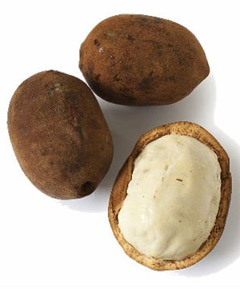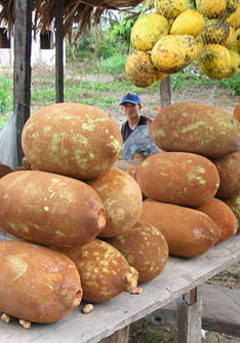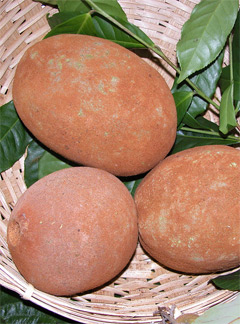Cupuaçu: The Pharmacy In A Fruit

Cupuaçu also spelled cupuassu, cupuazú, cupu assu, and copoasu, is a
tropical rainforest tree related to cacao. Common throughout the Amazon basin,
it is widely cultivated in the jungles of Colombia, Bolivia and Peru and in the
north of Brazil, with the largest production in Pará, followed by Amazonas,
Rondônia and Acre.
Cupuaçu (pronounced koo-poo-ah-soo) is a delicious melon-sized fruit with a
creamy white pulp that grows in the Amazon Rainforest drainage basin in northern
parts of Brazil. Cupuacu is known in the Amazon as “the pharmacy in a fruit” and
could be considered one of the most nutritionally beneficial superfruits ever
introduced to the marketplace. As a cousin of the cacao fruit, cupuaçu has a
prized tropical flavor combining elements of chocolate, bananas, pear, passion
fruit and pineapple.
Cupuaçu trees usually range from 5 to 15 meters (16 to 50 feet) in height,
though some can reach 20 meters (65 feet). They have brown bark. Their leaves
are 25–35 cm (10–14 in) long and 6–10 cm (2–4 in) across, with 9 or 10 pairs of
veins. As they mature, their leaves change from pink-tinted to green, and
eventually they begin bearing fruit. Cupuaçu fruits are oblong, brown, and
fuzzy, 20 cm (8 in) long, 1–2 kg (2–4 lb) in weight, and covered with a thick
(4–7 mm), hard exocarp.
The white pulp of the cupuaçu is uniquely fragrant (described as a mix of
chocolate and pineapple), and It is frequently used in desserts, juices and
sweets. The juice tastes primarily like a pear, with a hint of banana. Cupuaçu
is touted as a possible superfruit flavor. Commercial production of cupuaçu
includes food supplements, pills, drinks, smoothies and sweets. The pulp is also
used in cosmetics products such as body lotions, as it is highly hydrating,
similarly to cocoa butter.
Its flavors derive from its phytochemicals, such as tannins, the sulphated
flavone glycosides theograndins I and II, and other flavonoids, including
catechins, quercetin, kaempferol and isoscutellarein. It also contains the
alkaloid theacrine instead of the xanthines (caffeine, theobromine, and
theophylline) found in cacao.
Cupuaçu supports a phylogenetically intriguing butterfly herbivore the lagarta
verde, Macrosoma tipulata (Hedylidae), which can be a serious defoliator.
Cupuacu is extremely popular in South America, especially Brazil, and is poised
to become the next big super fruit to hit the U.S. Some nutritional food experts
are saying that it will eclipse the popular Acai because it's healthier, has the
same benefits, and is easier to grow without destroying rainforests.
The fruits are about the size of a medium-sized watermelon and become ripe from
January to April, during the rainy season. These are gathered, split open, and
the pulp is made into juice, ice cream, jam, tarts, smoothies and more. These
are considered delicacies in many of the larger cities of South America, such as
Rio, and are sold in shops of all description.
Traditionally it has been cultivated and used by indigenous peoples for
centuries. Nutritionally, Cupuacu is very compact and full. The ìbeansî (seeds)
were often given to people to chew to cure abdominal pains and the juice would
be blessed by shamans and given to pregnant women, newlyweds who wanted
children, and others for various maladies.
 Cupuacu came to the attention of many westerners when a Japanese company
attempted to trademark the name of the tree and fruit as well as the term
ìCupulateî to sell as a chocolate coffee-like drink. Brazil finally declared
Cupuacu to be the national fruit and the name to be ineligible for trademark. Cupuacu came to the attention of many westerners when a Japanese company
attempted to trademark the name of the tree and fruit as well as the term
ìCupulateî to sell as a chocolate coffee-like drink. Brazil finally declared
Cupuacu to be the national fruit and the name to be ineligible for trademark.
Health Benefits of Cupuacu
Cupuacu fruit has phytonutrient polyphenols (theograndins). These have a myriad
of nutritional benefits, which will be discussed more thoroughly below.
Cupuacu is also heavy with vitamins B1, B2, B3 (Niacin), fatty and amino acids,
and at least nine antioxidants (including Vitamins A and C). Being from the
cocoa family, Cupuacu also has a high flavanoid content.
There are many other ingredients in the nutritional content of these rainforest
fruits as well, including calcium, selenium, and others.
There are many health benefits to Cupuacu, most of which are tied to the fruit's
extremely potent phytonutrient polyphenols, anti-oxidants, essential nutrients,
vitamins, and others mentioned earlier.
It's primary health benefit is stimulating the immune system while
simultaneously supporting the body's ability to fight disease. Cupuacu has a
caffeine-like effect, but does not contain caffeine. It is one of the few cocoa
relatives that does not, yet it retains this energetic effect.
Most of the benefits of Cupuacu are synergistic. For instance, the
energy-boosting effect mentioned comes primarily as a result of the fruit's
heightening of the immune system, lowering of blood pressure, and the
body-boosting effects of the fast-acting nutrients and vitamins from the fruit.
Unlike most energy drinks or caffeine, however, there is no ìdownî with Cupuacu.
No tired feeling afterwards.
Still more synergistic effects include healthier skin and hair, lowered
cholesterol levels (through lipid peroxidation inhibition), and better libido.
These are some of the better benefits of the Cupuacu fruit.
Another huge benefit of the fruit is its extremely rich array and concentration
of antioxidants. These have a large number of longer-term effects on the body
including (and possibly most importantly) the neutralization of free radicals in
the body's tissues. The improved circulation and lowered blood pressure
mentioned already aid in this process of eliminating those free radicals.
Others of these antioxidants are what help lower cholesterol levels, improve
brain function, and more. Many of the essential vitamins and minerals are
boosters for the gastro-intestinal system (explaining the fruit's use by natives
for GI problems) as well as a healthier cardio-vascular system.
Cupuacu’s nutritional value is found in its complex array of nutrients including
nine flavonoids, polyphenols and theacrines. Unlike cacao which contains
xanthines (caffeine, theobromine and theophylline), cupuaçu contains theacrines
which produce similar mood and energy enhancing effects without the negative
effects of xanthines.
 Cupuacu’s primary health benefit is stimulating the immune system thus
supporting the body’s ability to fight disease. Cupuacu has an energetic effect,
but does not contain caffeine. It is one of the few cocoa relatives that does
not. Cupuacu’s primary health benefit is stimulating the immune system thus
supporting the body’s ability to fight disease. Cupuacu has an energetic effect,
but does not contain caffeine. It is one of the few cocoa relatives that does
not.
Cupuacu’s benefits are synergistic. For example, the energy-boosting effect
mentioned is a result of the fruit’s heightening of the immune system, lowering
of blood pressure and the overall body-boosting effects of the fast-acting
nutrients and vitamins from the fruit. Unlike most energy drinks or caffeine,
though, there is no tired feeling afterwards.
Other synergistic effects include healthier skin and hair, lowered cholesterol
levels and improved libido. In addition, many of the fruits nutrients are
boosters for the gastro-intestinal system and the cardiovascular system.
Common traditional uses for cupuaçu include:
- To lower blood pressure
- Healthy hair
- To lower cholesterol levels
- For Increasing libido
- To improve brain functions
- To boost gastro-intestinal (GI) systems
- To stimulate skin rejuvenation
- To achieve weight loss
- For combating diabetes
- To increase energy
Cupuaçu pulp is often used for making juice, ice cream, smoothies, mousse,
jellies, chocolates called “cupualte” and liqeur. The seeds are used for
producing “cupualte”, a product with similar characteristics to chocolate, but
which contains nutritional value and is healthier.
Dated 21 January 2014
|









